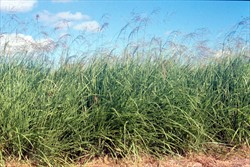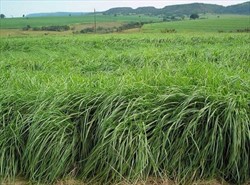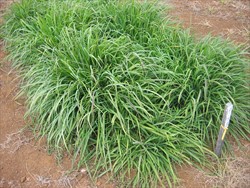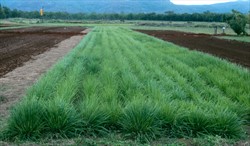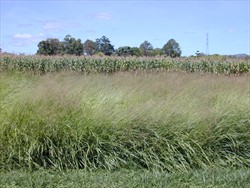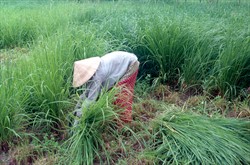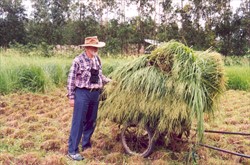Megathyrsus maximus × M. infestus
Tropical Forages
Megathyrsus maximus (Jacq.) B.K.Simon & S.W.L. Jacobs × Megathyrsus infestus (Andersson) B.K.Simon & S.W.L. Jacobs
Note: This hybrid name, while not formally accepted, is used to differentiate this group of fine-leafed grasses with characteristics intermediate between Megathyrsus maximus and M. infestus from the more familiar guinea grass types. Some authors choose not to differentiate and see them as a type within Megathyrsus maximus (Jacq.) B.K. Simon & S.W.L. Jacobs (syn. Panicum maximum Jacq.).
Panicum maximum Jacq. × Panicum infestum Andersson
Family: Poaceae (alt. Gramineae) subfamily: Panicoideae tribe: Paniceae subtribe: Melinidinae.
A leafy, densely tillered, perennial tussock, mostly 60–90 cm tall, to >1.5 m at maturity, and to 40 cm basal diameter. Culms fine, to 2.5 mm diameter. Leaf blades linear to 90 cm long, (3–) 5–8 (–10) mm wide; upper surface scabrous; sheath covered with short, dense, rigid, radiating hairs. Inflorescence an open panicle with the main axis to >25 cm long, and lower racemes to 20 cm long (may vary with cultivar); secondary branching of the racemes absent or much reduced. Spikelets similar in size and appearance to those of M. maximus, often purplish in colour. 900,000 seeds per kg.
English: guinea
Latin America: capim-massai (Brazil); pasto guinea (Spanish)
French: herbe de guinée C1
Native:
M. maximus × infestus is found in the centre of diversity of the two posited progenitor species in Tanzania and Kenya.
Cultivated:
Used in monsoonal and dry tropical environments in West Africa, Brazil, and Vietnam.
Forage
Mostly used for grazed or cut-and-carry permanent pasture for cattle, sheep, goats and horses. If cut young the high proportion of fine leaf makes it ideal for hay due to rapid drying and for silage due to effective compaction.
Environment
Provides a stable ground cover in sub-humid and seasonally dry environments, and has found agroforestry application in palm plantations.
Soil requirements
Grows best in fertile, well-drained soils, including cracking clays. Tolerates lower N and P fertility than cultivated varieties of M. maximus, but responds to applications of both nutrients. Also more tolerant of lower pH and higher aluminium saturation than is M. maximus.
Moisture
While usually grown in more humid environments with 1,000–2,000 mm rainfall, it is very drought tolerant, and can be grown with annual rainfall of (400–) 600–900 mm, with 5–7 (–8) months dry season.
Temperature
Growth is strongly warm season dominant. Best below 23° latitude, and from sea level to 1,000 m asl.
Light
Shade tolerance is probably moderate to good as in M. maximus; used in palm plantations in West Africa.
Reproductive development
‘Massai’ (see Cultivars) flowers through much of the growing season at 20–23º S, with a peak flowering from March to May. More restricted flowering period in higher latitudes. ‘C1’ flowers in March/April at Walkamin (17º S, Australia), and at the end of the rainy season in October at Dakar (15º N, Senegal).
Defoliation
In a grazing system, it should be maintained between 15–20 cm and 50–60 cm. A grazing rotation (1 week on / 4–5 weeks rest) is a good point to start, adjusting according to stock class and numbers, fertilizer use and rainfall. A similar cycle should be followed for cut-and-carry (see Nutritive Value).
Fire
No information available.
Guidelines for establishment and management of sown forages.
Establishment
Sown in rows 40 cm apart at 2–4 kg/ha or planted from splits on a 40 cm grid. Seed dormancy may be similar to that in M. maximus, so seed should be kept for several months after harvest before sowing.
Fertilizer
Responds to application of phosphorus in low P soils. If all other nutrients are non-limiting, productivity is strongly related to nitrogen availability, with good responses up to 150–300 kg/ha/yr N.
Compatibility (with other species)
Competes strongly for moisture and nutrient, and can have high levels of basal cover. Can form association with legume if managed to suit the legume.
Companion species
Grasses: Not usually planted with other grasses.
Legumes: Arachis pintoi, Neustanthus phaseoloides, Stylosanthes hamata.
Pests and diseases
Few pests or diseases of any consequence. ‘C1’ has resistance to root-knot nematode (Meloidogyne spp.), and ‘Massai’ to the spittlebug (cigarrinha), Notozulia entreriana.
Ability to spread
Spread only by seed. Can spread considerable distances from parent stand with little or no disturbance.
Weed potential
No indications of weediness.
Nutritive value
Nutrive value is usually lower than for M. maximus at similar stage and under similar conditions, but rate of decline is less than for most cultivars of M. maximus. It varies markedly with part of plant and age of regrowth. CP level in leaves, 12.5%, and in stems, 8.5%, and in whole plant, 11% in 4-week regrowth and 5% in 12-week regrowth. IVDMD mostly in the range of 50–55%.
Palatability/acceptability
Suitable for cattle, sheep and horses, but best utilized when young.
Toxicity
No record of toxicity.
Dry matter
Yields mostly of the order of 10–20 t/ha/yr, depending on moisture and amount of fertilizer used. Up to 50 t/ha DM in dry tropics with adequate N and irrigation. Higher yields than many M. maximus in similar environment.
Animal production
Cattle can gain 400 g/day in wet season (3 AU/ha) and at least maintain weight in the dry season (1 AU/ha); >600 kg/ha/yr at up to 4 AU/ha.
As noted under "Scientific name", this group of fine-leafed grasses is morphologically intermediate between M. maximus and M. infestus and may be a spontaneous hybrid between the two. ‘C1’ is tetraploid (2n = 4x = 32), 97% apomictic.
Seed sheds as it matures, so large losses, particularly with windy weather, as in M. maximus. Harvested in May in southern hemisphere. Seed yields of 80–100 kg/ha. Direct heading can provide 75% of the harvested yield, and threshing of windrows the remainder.
No record, but probably similar to those for M. maximus.
- Drought tolerant.
- Low, dense, very leafy.
- Palatable when young.
- Better ground cover than M. maximus.
- Better adapted to low P and high Al than M. maximus.
- More tolerant of low pH and high Al saturation than M. maximus.
- Not tolerant of waterlogging or poor drainage.
- Nutritive value declines rapidly.
Cesar, J., Zoumana, C.J. and Dulieu, D. (1999) L’association fourragère à Panicum maximum et Stylosanthes hamata en Côte d’Ivoire. Fourrages 157:5–20. bit.ly/2URNa9H
Embrapa Gado de Corte (2001) Capim-Massai (Panicum maximum cv. Massai): alternativa para diversificação de pastagens. Communicado Técnico No. 69. Embrapa Gado de Corte, Campo Grande, Brazil. old.cnpgc.embrapa.br/publicacoes/cot/COT69.html
Noirot, M., Messager, J.L., Dubos, B., Miquel, M. and Lavorel, O. (1986) La production grainière des nouvelles variétés de Panicum maximum sélectionnées en Côte d’Ivoire. Fourrages 106:11–18. bit.ly/344fgTi
Van Man, N. and Wiktorsson, H. (2003) Forage yield, nutritive value, feed intake and digestibility of three grass species as affected by harvest frequency. Tropical Grasslands 37:101–110. bit.ly/3bzPBnZ
'BRS Tamani' Released in Brazil (2015). Fine-leafed hybrid with M. maximus as the female parent and M. maximus × M. infestus T60 as the pollen parent, created by Embrapa Gado de Corte. Selected for productivity and vigor, high quality (>'Massai'), ease of management and resistance to spittlebugs. It is not tolerant of even temporary flooding, and is primarily for use on well drained soils in the cerrado environment, as well as in the Amazon and Atlantic Forest regions. It is more persistent in cooler areas than 'Massai' and 'Tanzânia-1' and similar to 'Mombaça'.
‘C 1’ (ORSTOM T19) Côte d’Ivoire (1980s). Derived from T 19, origin Bagamoyo, near Dar-es-Salaam, Tanzania. The original collection of T19 proved to be a tetraploid apomict with a high rate of facultativeness. Several haploid (or polyhaploid, i.e. 2n = 2x = 16) off-types were identified and tested to determine whether apomixis could be expressed at the diploid level. Most individuals from this population were eventually found to be entirely sterile (regardless of pollen applied) and had degenerated or died. One line from this small population that was much more vigorous than the others, proved to be tetraploid, possibly through spontaneous duplication, and was numbered 'C1'. It has all the vegetative characteristics of T19, but not the facultativeness. The work was carried out by ORSTOM at Adiopodoumé near Abidjan, Côte d’Ivoire, and 'C1' was further evaluated in Côte d’Ivoire, Senegal, Nigeria, French Guiana, and New Caledonia. Used in palm plantations in West Africa.
‘Massai’ (ORSTOM T21, BRA 007102) Brazil (2001). Origin Bagamoyo, near Dar-es-Salaam, Tanzania. Perennial, up to 60 cm tall, very leafy, long, thin leaves up to 0.9 cm wide, purplish seed heads. Selected on the basis of persistence in less fertile, more acid soils in areas where spittlebugs (cigarrinha), Notozulia entreriana, are a problem in Urochloa brizantha cv. Marandu; spittlebug tolerance similar to that of ‘Tanzânia-1’ (M. maximus), and greater than that for ‘Mombaça’ (M. maximus). Tolerant of intensive grazing, and suitable for cattle, sheep and horse grazing.
Note: Cultivars have near identical appearance, but have been evaluated separately, and under different conditions.
K 280 Selected in Vietnam. Popular in cut-and-carry dairy systems around Ho Chi Minh City. Rainfall 1,900 mm, 5 month dry season. Produced higher DM yields than Cenchrus purpureus cv. King grass and Megathyrsus maximus (I 429).
